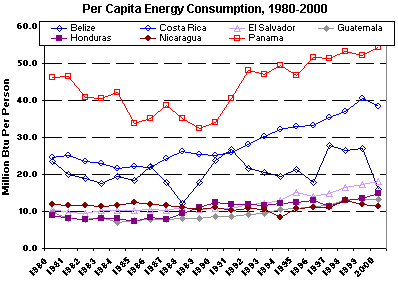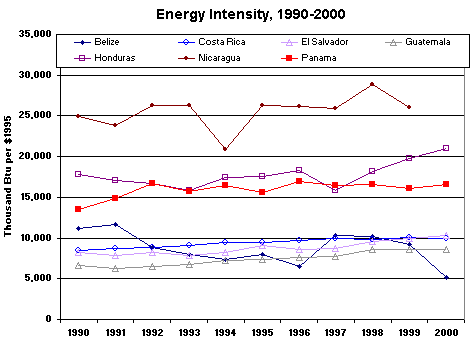
Central America: Environmental Issues
 Introduction
Introduction
The countries of Central America (Belize, Costa Rica, El Salvador, Guatemala,
Honduras, Nicaragua and Panama) comprise an area rich with a diverse range of
plant and animal life. It is estimated that approximately 7% of the world's
animal species live in Central America, a narrow strip of forests and beaches
that accounts for only 0.5% of earth's land area. The population of Central
America is approximately 37 million, with a yearly growth rate of about 3%.
Although Central America has been plagued for decades by civil wars and natural
disasters, the region witnessed a period of economic growth throughout the 1990s.
Expanding economies coupled with growing populations have put significant new
stresses on the environment in Central America. Observers from around the world
have concluded that the environmental quality of the region is in rapid decline.
Despite its recent economic growth, Central America remains one of the poorest
regions on earth; a fact which has led to massive exploitation of the area's
natural resource base. Large areas of forest have been cut down and burned for
firewood or used in the production of paper, while significant portions of land
have been cleared for agricultural use. Approximately half of all Central Americans
live in rural areas, and it is estimated that the average family living below
the poverty line burns approximately 12 tons of firewood a year. Also, as a
result of oil exploration activities in certain parts of Guatemala, such as
the northern Peten rainforest region, the building of roads has led to the clearing
of land and forested areas. These activities have contributed to large-scale
erosion and soil loss, leaving many areas vulnerable to flash floods and mudslides
as the natural landscape's ability to retain water is jeopardized. The effects
of the land degradation were felt most significantly in 1998, when Hurricane
Mitch -- the region's most violent storm in over 200 years -- hit large parts
of Central America, wreaking havoc on the economy and ecological landscape of
many parts of the region. In Honduras alone, the hurricane killed more than
5,000 people, injured more than 2 million, and caused billions of dollars of
damage.
Oil is the chief source of energy in most areas of Central America, and pollution
from cars, industry, and power generation is a major problem in several areas.
However, Central America is not a major producer of greenhouse gases, accounting
for only about 0.2% of 2000 world carbon emissions totals. Central America,
due to its contribution to carbon sequestration levels (the amount of carbon
dioxide and other greenhouse gases absorbed by the region's forests) plays an
important role in the Climate Change issue. Every Central American country has
signed and ratified the United Nations Framework Convention on Climate Change.
As non-Annex I countries, they are not obligated to reduce their emissions of
greenhouse gases.
Per Capita Energy Use and Carbon Emissions
 Per capita energy consumption in Central American countries is significantly
lower than the per capita energy consumption levels of many Latin American countries.
In 2000, the average per capita energy consumption of Central American countries
measured approximately 24 million British thermal units (Btu) per person. Among
these countries, Panama had the highest level of per capita energy consumption
at 54 million Btu, more than double the regional average. As a whole, Central
American countries consumed 0.73 quadrillion Btu of energy in 2000 (0.2% of
the world's total).
Per capita energy consumption in Central American countries is significantly
lower than the per capita energy consumption levels of many Latin American countries.
In 2000, the average per capita energy consumption of Central American countries
measured approximately 24 million British thermal units (Btu) per person. Among
these countries, Panama had the highest level of per capita energy consumption
at 54 million Btu, more than double the regional average. As a whole, Central
American countries consumed 0.73 quadrillion Btu of energy in 2000 (0.2% of
the world's total).
In 2000, Central America's per capita carbon emissions were 0.3 metric tons,
slightly (0.1 metric tons) less than the region's per capita carbon emissions
in 1998 and 1999, and well below the world average. Because of Panama's relatively
small population (2.86 million people in 2000), the role the country plays as
a major center of maritime trade, and its relatively substantial industry and
urbanization, per capita carbon emissions tend to be relatively high. In 2000,
Panama had the highest rate of per capita carbon emissions in Central America,
at 0.8 metric tons - four times the per capita carbon emissions in Guatemala
(0.2 metric tons). Central America's per capita carbon emissions are expected
to remain low in both the near and long-term as the region continues to develop
its energy sector based on the use of cleaner sources of energy such as hydropower,
which emits no carbon.
Central America contains little in the way of energy resources, with Guatemala
being the region's only producer of oil. Oil is the primary fuel in Central
America, followed by hydropower. In 2000, these two energy sources accounted
for 70% and 22% of total energy consumption in the region, respectively. Although
a negligible amount of coal is used in Central America, in January 2000, Guatemala
began operating the 120-MW San Jose Power Station - the first coal-fired plant
in Central America. Neither natural gas nor nuclear power is used in Central
America.
Energy and Carbon Intensity
 Energy intensity in Central America is on par with the energy intensity levels
of most other countries in Latin America. In 2000, Central America consumed,
on average, approximately 13,940 Btu per $1995. The region's average energy
consumption per dollar of GDP has increased moderately over the last ten years,
from 12,970 Btu per $1995 in 1990. Nicaragua has consistently had the highest
energy intensity in Central America, with 25,980 thousand Btu per $1995 in 1999.
Energy intensity in Central America is on par with the energy intensity levels
of most other countries in Latin America. In 2000, Central America consumed,
on average, approximately 13,940 Btu per $1995. The region's average energy
consumption per dollar of GDP has increased moderately over the last ten years,
from 12,970 Btu per $1995 in 1990. Nicaragua has consistently had the highest
energy intensity in Central America, with 25,980 thousand Btu per $1995 in 1999.
Carbon intensity in Central America is comparable to the carbon intensity levels
of its Latin American neighbors. In 2000, carbon intensity in Central America
averaged 0.21 metric tons of carbon per thousand $1995. The amount of carbon
consumed per dollar of GDP in Central America has remained relatively stable
since 1980, most likely reflecting the region's growing use of hydropower, which
emits no carbon.
Air Pollution
Like much of Latin America, Central America's urban centers experienced large
population growth throughout the 1990s. This growth has in most cases resulted
in an increase in the number of motor vehicles, thus leading to the growing
problem of urban air pollution. The number of motor vehicles in the region has
increased up to 16% each year. It is estimated that nearly 70% of all urban
air pollution in the Central American region is caused by vehicular traffic.
This has caused serious health problems in the region. Since the end of Guatemala's
civil war, respiratory ailments have been considered Guatemala's most common
illness.
The chief pollution sources in Central America have traditionally been poorly
maintained trucks and buses which run on lower quality fuels, such as leaded
gasoline. However, the majority of countries in Central America have recently
phased out the use of leaded gasoline, with Panama being the region's only nation
to still permit the use of leaded gasoline for transportation.
Costa Rica is the regional leader regarding air quality. In 1996, it banned
the use of leaded gasoline and has since reduced its ambient lead levels by
two-thirds. Furthermore, every motor vehicle in Costa Rica must now pass an
annual emissions inspection, and imported cars must come equipped with catalytic
converters. Although much remains to be done regarding the process of improving
the air quality of Central American cities, the region's countries appear to
be making positive strides.
In May 2002, Mexico and Guatemala signed an environmental accord enabling Guatemala
to draw from Mexico's experience battling urban air pollution, illegal logging,
and other environmental issues. It is estimated that Guatemala lost approximately
1/3 of its forests in the last ten years alone. The May 2002 accord extends
previous agreements on forest reserves and natural resources.
Hydropower and other Renewable energy
Notwithstanding the dominance of oil use in Central America's power sector,
hydropower is extremely important to several of the region's countries as a
primary source of power. Several Central American governments, such as Panama,
Guatemala, Costa Rica, and Belize recently have initiated hydroelectric projects
in their countries as a means of attracting foreign investment and of developing
a more competitive market. However, there remains uncertainty regarding the
future of hydropower in certain areas of Central America.
In September 1999, the government of Honduras ordered the evacuation of 100,000
people from the vicinity of the El Cajon hydroelectric dam, following two weeks
of heavy rains and flooding which threatened to breach the dam. The dam, which
provides almost 60% of the country's electricity and $8 million a year in electricity
exports, illustrates the concerns over hydropower's viability in areas that
are prone to heavy rain and flooding. The building of hydroelectric dams has
also widely been blamed for the destruction of large portions of Central American
forests.
In December 2001, the United Nations Environment Program
launched a project to to map the solar and wind resources of 13 developing countries,
including El Salvador, Guatemala, Honduras, and Nicaragua. The project, known
as the Solar and Wind Energy Survey Assessment (SWERA), aims to provide potential
investors with accurate information about renewable energy resources in these
countries in order to accelerate investment.
Environmental Outlook
The governments of Central America face a difficult environmental challenge
in coming years. Central America's greatest environmental challenge is that
of sustainable development, as deforestation, loss of biodiversity and degradation
of the region's land continue to increase. The region is, however, the beneficiary
of significant sources of institutional and monetary help from numerous outside
organizations such as the World Bank, the United States Agency for International
Development, (USAID) the U.S. government, and non-governmental organizations
(NGOs).
At the 1994 Summit of the Americas, the Central America-U.S. Joint Accord (CONCAUSA)
agreement was signed in an effort to achieve a sustainable level of development
in the region by focusing on the areas of environmental protection and natural
resource management. The CONCAUSA agreement also includes energy initiatives
for improving overall energy efficiency and energy distribution within Central
America, as well as the further development of renewable energy resources. More
recently, the CONCAUSA agreement established the Mesoamerican Biological Corridor
- an attempt to protect critical habitat along the land bridge from Mexico to
Panama. In 1999, the Clinton Administration committed to a second five-year,
$25 million program in support of CONCAUSA. In October 2001, the U.S. government
announced that it will donate an additional $11 million over three years for
environmental protection in Guatemala.
Unfortunately, the Central American region remains far away from restructuring
its land-use management policies, as it has yet to place in force some sort
of effective environmental regulatory structure. However, an increasing awareness
of the need to promote the idea of sustainable development, has begun to take
root and provide room for sustainable economic development.